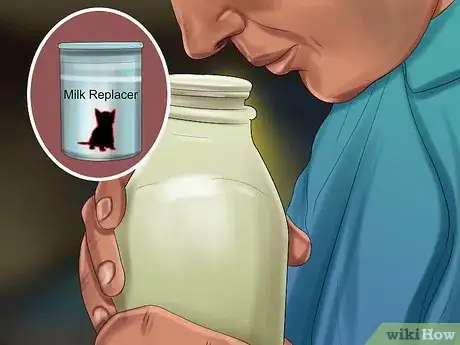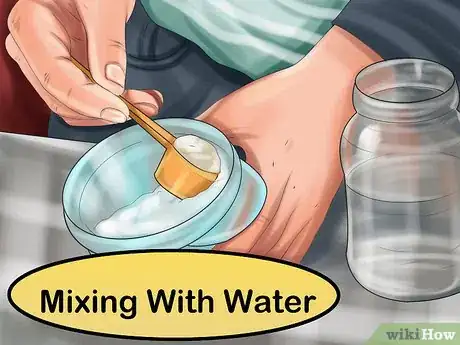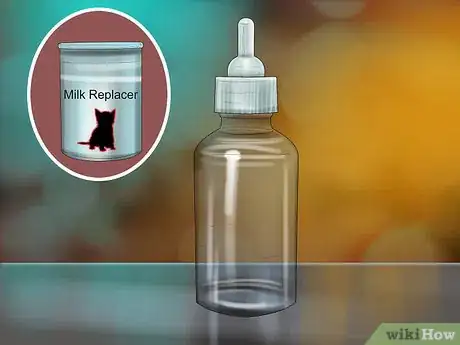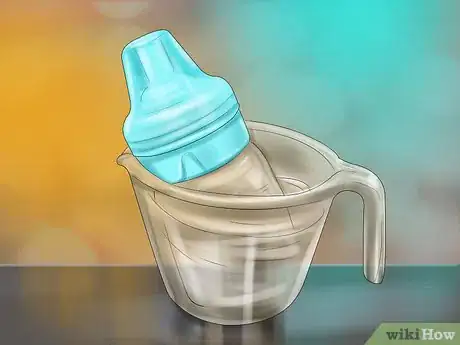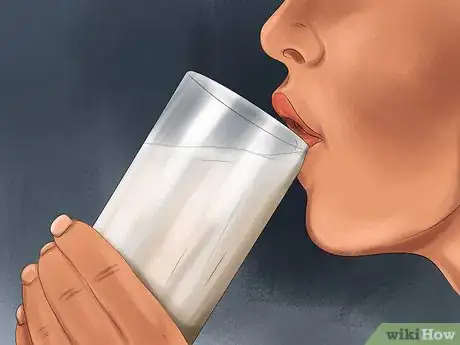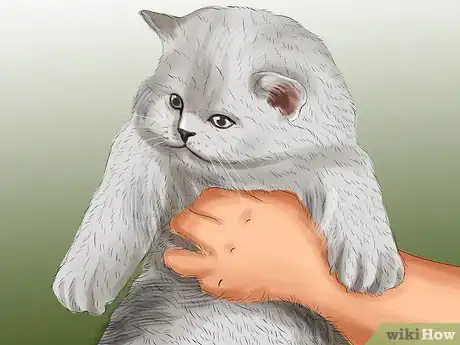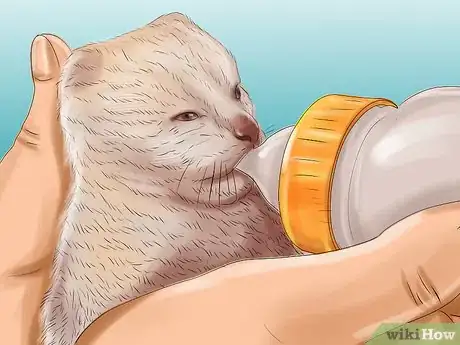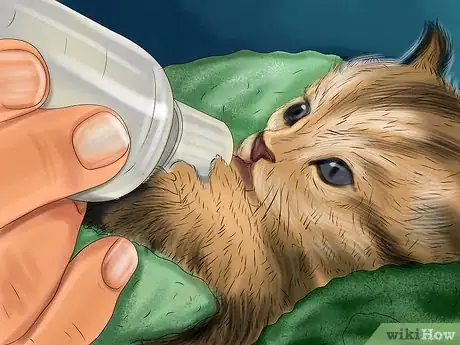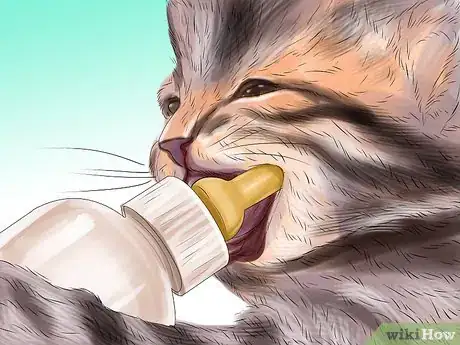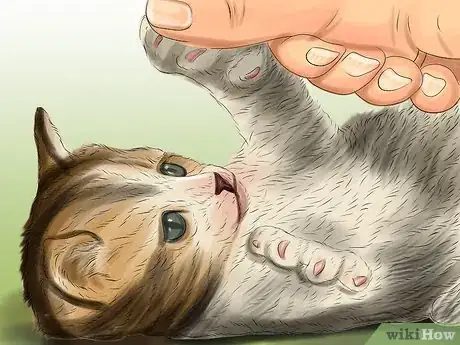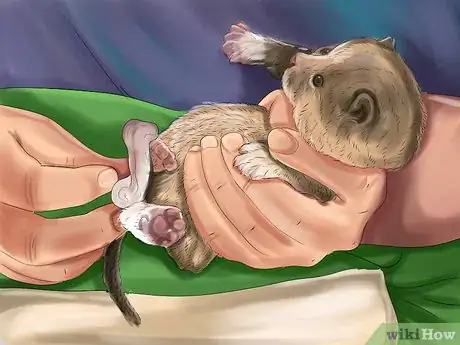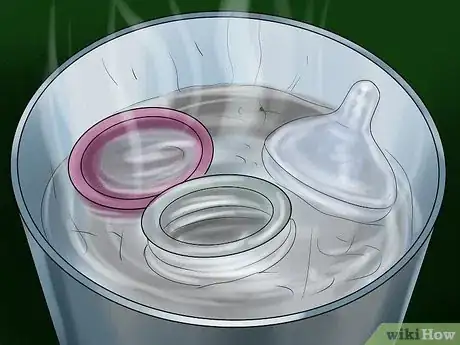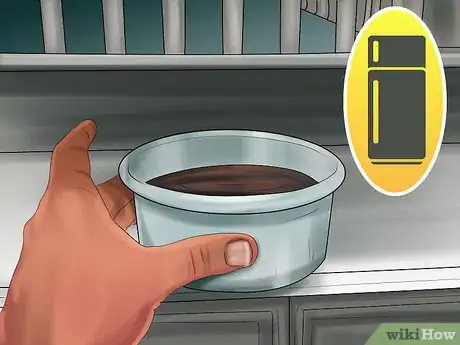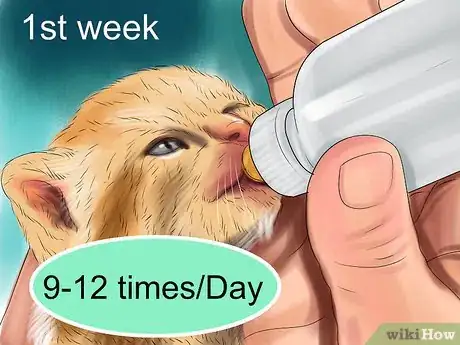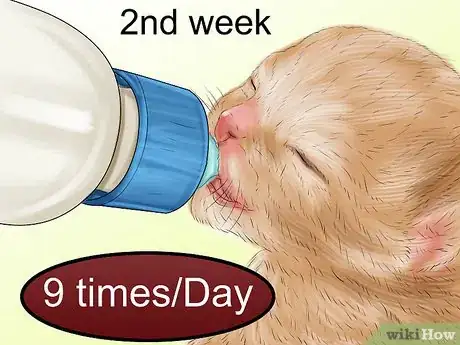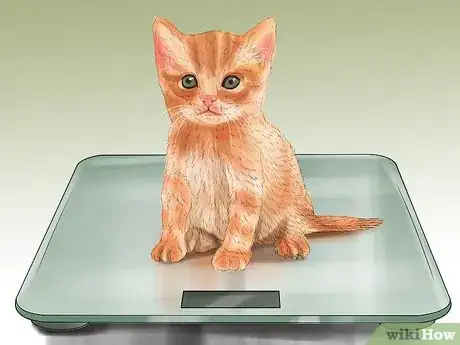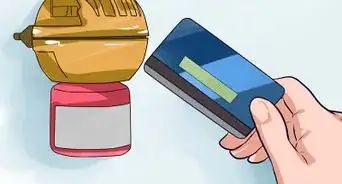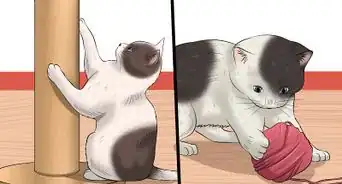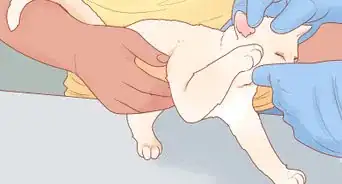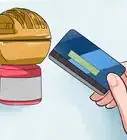This article was co-authored by Pippa Elliott, MRCVS. Dr. Elliott, BVMS, MRCVS is a veterinarian with over 30 years of experience in veterinary surgery and companion animal practice. She graduated from the University of Glasgow in 1987 with a degree in veterinary medicine and surgery. She has worked at the same animal clinic in her hometown for over 20 years.
There are 8 references cited in this article, which can be found at the bottom of the page.
This article has been viewed 12,302 times.
Kittens are very vulnerable in the first weeks after birth and are at their healthiest when raised by a mother. If their mother is not available, it is best to find a foster mother who will feed them. However, with constant, vigilant care, you can keep orphaned kittens going with nutrient rich commercial milk replacements.
Steps
Preparing for the Feeding
-
1Test the kitten’s temperature. It can be dangerous for a kitten to be fed cold milk when it is already cold. Feel the pads of the kitten’s feet and place your finger in the kitten’s mouth. If either is too cold, slowly warm up the kitten.[1]
- This step is particularly important if you have found the kitten outside. However, even normal room temperature is uncomfortable for a kitten. At one week old, kittens prefers a temperature of 86 to 90 degree’s Fahrenheit. This will gradually decrease over the next three weeks to approximately 75 degrees Fahrenheit.
-
2Warm the kitten. If your kitten feels cold or even cool, wrap it in a towel or blanket. Hold it close to your body and rub it continually. Give it approximately 20 minutes to warm up.[2]Advertisement
-
3Smell the milk replacer. Open the lid of the milk replacer and sniff it. It should smell sweet, like condescended milk. If it has a strong smell or is past the expiration date, toss it out.[3]
-
4Mix water with powdered milk replacer. The box should have instructions about the ratio of powder to water. Follow these instructions closely.
- There are canned formulas that are premixed. These, however, can cause diarrhea, which can be dangerous for kittens. It is best to use a powdered milk replacer, if possible.[4]
- Verify that the milk replacer is specially designed for kittens. Kittens have special dietary needs that make other types of milk inappropriate.
-
5Fill the pet nurser bottle with milk replacer. You will need a specialized pet nurser that releases a single drop of liquid at a time. Only put in as much milk replacer as you intend to feed the kitten that sitting.[5]
- A baby bottle will release liquid too quickly, choking the kitten.
- There are tubes that can be used to administer milk replacer to kittens who are reticent to eat. However, these can be extremely dangerous for a non-professional to handle. Visit your veterinarian for guidance before using one of these.
- If the bottle does not come with hole in the nipple, use a cuticle cutter to make a very small hole in the nipple. Make the hole as small as possible. Cutting too large a hole is a mistake you cannot correct. After cutting the hole, the replacer should drip out, not flow in a steady stream.[6]
-
6Warm the bottle in a glass of hot water. Cats prefer to drink milk at approximately 100 degrees Fahrenheit. A microwave, however, will heat the milk unevenly, possibly burning and injuring the kitten. Fill a bowl or glass with hot water and place the bottle in it for a couple of minutes, allowing it to warm up.
- Err on the side of cooler milk. You do not want to accidentally burn the kitten.
Administering the Milk Replacer
-
1Test the milk. Try a taste of the milk. Verify that it is not sour—which means that it has gone bad—and that it is not scalding hot or extremely cold. Also, make sure that the milk is truly kitten milk replacer (KMR) and not just cat milk, which is cow’s milk with the lactose removed and will not meet the nutritional needs of a kitten.
-
2Hold the kitten horizontally on its stomach. Keep the kitten close to you, in a blanket, lying down. Its head should be in the neutral position-parallel with the rest of its body and well supported.[7]
- Holding your kitten while you feed it will help socialize it. It also keeps it warm.
-
3Allow the kitten to suck on the bottle. The kitten should naturally suck on the bottle. It ought to eat until it is satisfied. If your kitten does not want to use the bottle, consult a veterinarian about using a tube to feed your kitten.
- Once the nipple is in the kitten's mouth, try wiggling it a little. This will cause some milk to come out and help the kitten understand what is happening.[8]
- If the kitten is still reticent to eat, gently rub the kitten's back or head. This reminds the kitten of its mother.
-
4Slow down if the kitten milk is coming out of the kitten’s nose. It is common for milk to come out of the kitten’s nose when it is eating. It generally is not dangerous, but it is a sign that it is eating too quickly. Stop briefly or hold the bottle at a less extreme angle.
- Hold the bottle at approximately a 45 degree angle. Do not hold the bottle at an angle that allows the kitten to swallow air.
-
5Stop when the kitten no longer seems interested in the bottle. The kitten should stop sucking on the bottle when it is full. There are guidelines for how big feedings should be in each week of infancy, but feedings can vary somewhat depending upon the kitten’s appetite.
- If the kitten falls asleep while feeding, you can gently nudge it awake.
Developing a Post-Feeding Routine
-
1Play with the kitten. Spend a few minutes after the feeding to play with or rub the kitten. This socializes it and helps burp it, making it feel better after a big feeding.
-
2Rub the kitten's private parts with wet cotton swab. Normally, a mother will lick the kitten to encourage it to urinate and defecate. Without the mom, you will need to fill that role. Rub the genitals gently with a wet cotton swab. Rub the anus too, if the kitten does not appear to be defecating.
-
3Sanitize the bottle. The bottle and nipple should be washed and then boiled in water. Perform this cleaning between each feeding.[9]
-
4Refrigerate opened formula. The formula, like milk, is very susceptible to spoiling when left out. Toss out any formula that has gone more than an hour without refrigeration. An open container that has not been out for long, should be returned to the refrigerator.[10]
- This applies to both powdered and canned formula.
- Don’t prepare more formula than can be used in a 24 hour period.[11]
Keeping a Healthy Feeding Schedule
-
1Feed the kitten 9-12 times a day in the first week. You should feed your kitten approximately once every three hours, possibly more. Each feeding should be between 1-7 ml, totaling 32 ml per day.[12]
- Sleep with your kitten nearby, because it will want to eat throughout the night. Do not wake it for feedings. It will wake you by crying.
-
2Feed the kitten nine times a day in the second week. You should feed the kitten slightly less frequently at two weeks, but you should feed it more milk replacer in each feeding. Feedings should be between 7-9 ml for a total of about 60 ml per day.
-
3Feed the kitten nine times a day in the third week. The kitten will begin to consume more with each feeding. It should consume about 10 ml each feeding for a total of 90 ml per day. You should try to introduce it to solid food during this week.[13]
-
4Reduce feedings to seven times a day. The kitten should eat more during its fourth week, but it will be getting much of its nutrition from solid food. Reduce feedings to seven per day, about 10 ml each.[14]
-
5Provide kitten food after the fourth week. From the fourth week of the kitten’s life onwards, you can provide the kitten with some kitten food. Leave the food out at all times for the kitten to try when they want to. This will begin to wean the kitten off of the kitten milk replacer.
-
6Weigh the kitten and adjust diet accordingly. Weigh the kitten every day on a precise electronic scale to mark its progress. If the kitten is not meeting benchmarks, try to increase food intake. The kitten should weigh approximately:
- 100-200 grams (.22-.44 lbs) in its first week
- 200-300 grams (.44-.66 lbs) in its second week
- 300-360 grams (.66-.79 lbs) in its third week
- 350-420 grams (.77-.93 lbs) in its fourth week.[15]
References
- ↑ http://www.animalalliancenyc.org/wordpress/2013/05/what-to-do-and-not-do-if-you-find-a-newborn-kitten/
- ↑ http://www.animalalliancenyc.org/wordpress/2013/05/what-to-do-and-not-do-if-you-find-a-newborn-kitten/
- ↑ http://www.animalalliancenyc.org/wordpress/2013/05/what-to-do-and-not-do-if-you-find-a-newborn-kitten/
- ↑ http://www.animalalliancenyc.org/wordpress/2013/05/what-to-do-and-not-do-if-you-find-a-newborn-kitten/
- ↑ https://vcahospitals.com/know-your-pet/feeding-orphaned-kittens
- ↑ http://www.communityconcernforcats.org/resources/bottle-babies/
- ↑ http://bestfriends.org/resources/bottle-feeding-kittens#Feeding
- ↑ http://bestfriends.org/resources/bottle-feeding-kittens#Feeding
- ↑ https://vcahospitals.com/know-your-pet/feeding-orphaned-kittens
- ↑ Mrwww.animalalliancenyc.org/wordpress/2013/05/what-to-do-and-not-do-if-you-find-a-newborn-kitten/
- ↑ https://vcahospitals.com/know-your-pet/feeding-orphaned-kittens
- ↑ http://www.peteducation.com/article.cfm?c=1+2137&aid=912
- ↑ http://www.peteducation.com/article.cfm?c=1+2137&aid=912
- ↑ http://www.peteducation.com/article.cfm?c=1+2137&aid=912
- ↑ http://www.peteducation.com/article.cfm?c=1+2137&aid=912
About This Article
To feed your newborn kittens commercial milk replacer, get powdered milk replacer that’s specifically designed for kittens rather than canned formulas or other types of milk which can be harmful to kittens. Then, follow the instructions on the box for how to mix it with water. Once you have the properly mixed milk replacer, put it in a special pet nurser bottle so you can release one drop of liquid at a time and not hurt the kitten by giving it too much at once. Next, hold the kitten horizontally on its stomach and let it suck on the bottle until it’s satisfied. For more tips from our Veterinary co-author, including how to keep a healthy feeding schedule with your newborn kittens, scroll down!


